Heiko’s travels have taken him to many places – specially to aquatic habitats – around the world. He continuously studies the environment in the most remote places and possibilities to protect the same, as hardly any freshwater habitat has been protected and it is the basis of our lively hood. Mainly in the so-called “third world countries” no creek, river or lake is been conserved or protected. He just returned from an trip to the Western Ghats in India and of the 37 rivers and lakes he researched 35 were used as garbage disposal. At the same time a fight over water sources is going on, as many do not have access to it … Heiko always remembers, one time during a visit in Timbuktu, Mali, the German president had also arrived to inaugurate a new dam financed by his government but there was no water. They had built the dam in the middle of the desert and when he questioned its reason, the answer was “we are waiting for water, although it has not rained for 15 years but normally it does rain every 12 years … ”.
Such projects he rejects to support or even talk about, but there are aquatic areas he follows up to help, cooperate or to propose a protection for the same. This is one of his future projects. Another one of his priorities is his aim to do more research expeditions – in spite of his 800plus destinations researched in 5 continents already. And last but not least, there is a series of publications he wants to finalize. Below is a summary of those three main projects:
Conservation Projects of aquatic habitats
Expedition and Research Projects
Publication Projects – Popular and Scientific
Conservation projects of aquatic habitats – in desperate need for protection:
1. Protection of one of the most prestigious aquatic habitats on planet Earth – the richest in aquatic live forms – lies in the upper Rio Guaporé region, near the border of Brazil with Bolivia. Heiko has recorded in this relatively small river and its lakes almost 500 different fish species (more than in Europe), his mother more than 60 aquatic plant species and the famous German naturalists Spix and Martius already in the 1820s declared this region the bird paradise of the world. Giant cattle ranching has already taken its toll, more than 200 million head roam the area and almost every single tree of this former largest primary rainforest is history. If one of the species richest Rio Guaporé region environment and its pristine aquatic environment has a chance to survive for future generations an urgent action has to take place. Sponsors are welcome. Detailed information of the area, river, photos and statistics can be supplied, as well as photos.

A typical Guaporé – untouched – aquatic environment
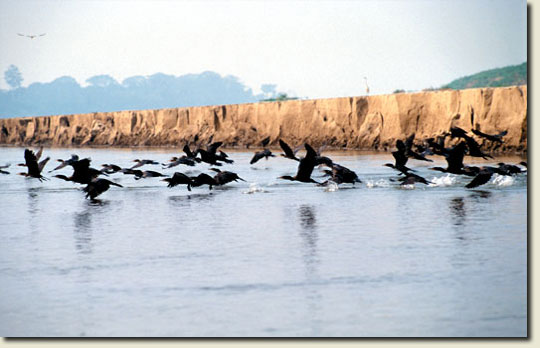
The Guaporé is an bird paradise almost unmatched elsewhere
2. Protection of one of the most precious and most beautiful freshwater lakes in the world is needed urgently: Lac Fwa in the Democratic Republic of the Congo. This crystal clear karst lake with a length of 22 kilometers in the province of Kananga hosts at least 10 endemic, some of the most colorful cichlids (Perciformes: Cichlidae) on Earth, and many other aquatic live forms only found in this lake and nowhere else in the world. The area around the lake is completely deforested and the place is turning into a complete desert-region. The lake’s water is threatened by tremendous pollution, as well as by the introduction of exotic species. Also for this project sponsors are asked to help immediately. There is plenty of photo material and detailed information available – also areal views of the region.
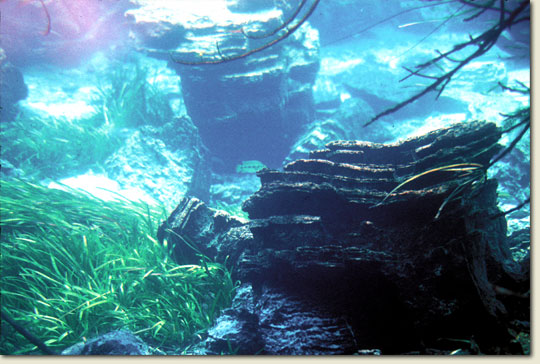
Lac Fwa is a unique karst Lake – here an under water photo of a karst
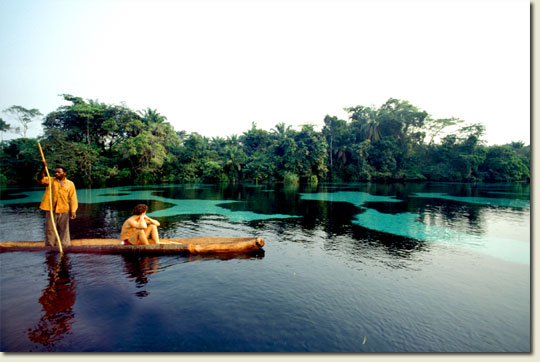 The water of Lac Fwa is transparent – cristal clear – with a wealth of aquatic plants
The water of Lac Fwa is transparent – cristal clear – with a wealth of aquatic plants
and beautiful vegetation surrounding the lake
 The cichlids in the lake are all endemic and some still undescribed
The cichlids in the lake are all endemic and some still undescribed
3. Another African aquatic region that needs immediate protection is the Sangha river along the border between Cameron and Central African Republic. This part of the world has not only some of the largest accumulation of still living forest gorillas and elephants, but also a unique aquatic flora and fauna. Heiko has discovered several new species here, but only a fraction of what lives there has been identified. In this region gigantic logging is taking by international logging companies and the government taking its share. This is going on for more than a decade and the entire nature and the environment is threatened by extinction of unique life forms, including a endangered tribe of pygmies. This aquatic habitat and the region is in urgent need of protection, and also of this area extensive photographic material is archived and can be shown to possible sponsors and/or sponsoring organizations.
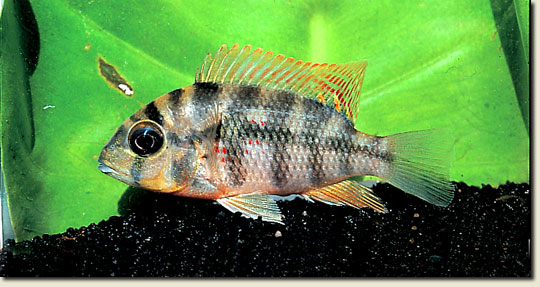
Heterochromis multidens one of the endemic species

The Sangha river with extensive deforestion along its right-hand river region taking place

The endemic pygmy-tribe of this region with Heiko Bleher
These are just three of the immediate aquatic habitats that need protection, but there are many more Heiko can (and will) list soon others.
Expedition and Research Projects – only a few of those coming up can be mentioned here:
1. Research on the Tibet Plateau – here lives the highest freshwater fish species of planet Earth at 5800 meters above Sea level. This rare species lives in fast flowing rivers, which freeze over most of the year. They have never been photographed alive and only a few preserved specimens have been deposited at the Academia Sinca, in Wuhan, China. The species belongs to the genus Triplophysa Rendahl, 1933 (family Baltoridae), it has never been studied in nature and we do not know anything about its biology and know almost nothing of its ecology. It is imperative to find more about this fish and how it can survive at such altitudes – an extreme important study for mankind, which will surely give us unique information on survival methods.

Triplophysa yarkandensis (69.5 mm SL) collected at 5876 m high at the Tibet Plateau,
deposited at Academia Sinica, Wuhan, China
2. Research expedition to the southern most islands of South America. There, at the Hardy Peninsula lives the southern most freshwater fish species confined to alpine lakes. Collections have to be made because only with those, taxonomy studies will show if this species is G. alpinus Smitt, 1901, or G. maculatus (Jenyns, 1842) – which also occurs in New Zealand and Australia – or if it is a new species. This amazing fish and its survival strategy must be researched, as well as its biology living in icy lakes. Such a research expedition is also very important in regards to the evolution of those species, as its members (those of the family Galaxiidae) are today only found in southern South America, the most southern tip of Africa, southern Australia, Tasmania, New Zealand and on the southern tip of New Caledonia. Possibly those are relicts of the period of Gondwana and belong to some of the most ancient fishes.


Left: Galaxias alpinus? or G. maculatus? from Lago Riñhue, Valdivia Province, Southern Chile.
Photo by K. Busse
Right: Galaxias maculatus from the Victoria Coast, Australia. Photo by N. Armstrong
3. Heiko’s research on the myth of the fresh water seahorse is going on. He traveled twice to the Mekong river and collected there extensively, but was unable to find any, although it was described from above the giant waterfalls as Hyppocampus arnei by the Frenchman Roule in 1916. Later Heiko found out, in the Paris Museum, that the types have a hole in the middle and were taken from the wall of a fishermen’s hut… This “Mekong” species was later (1999) placed in synonymy to the marine species H. barbouri Jordan & Richardson, 1908. In the meanwhile Heiko has discovered, that there is a freshwater Seahorse known from Lake Titikaka and researched the highest navigable lake in the world as well (see aqua geõgraphia vol. 24 and Aquaristik Fachmagazin Nr. 193). It is an ongoing research project – also in other parts of the world… until he finds it in freshwater …
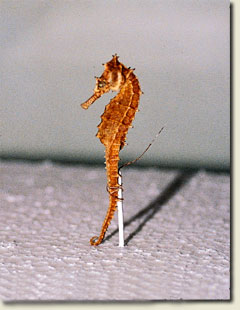

The label below the seahorse (left) in the Museo de Archeologia in Tiwanaku, Bolivia,
reads Hippocampus titicacaensis. There is an account of the discovery of this seahorse
by the archeologist Arthur Posnansky in Lake Titicaca in 1943; also, a clay
seahorse (right) dating back more than 2000 years has been unearthed in the area. This is also
on display in the museum, and a team is working to verify this surprising discovery of
what may be the only freshwater seahorse in existence. Photos by H. Bleher
4. On several expeditions Heiko has researched the Mamberamo Valley in Indonesia, the largest swamp area and probably the least explored region on Earth. He was able to find there the most fantastic rainbowfish, Melanotaenia preacox, as well as many other fish species, including new ones. His research aim continues in that remote area and although it is almost impossible to get permits and enter this giant valley – surround by high mountain ranges – he continues to do so …
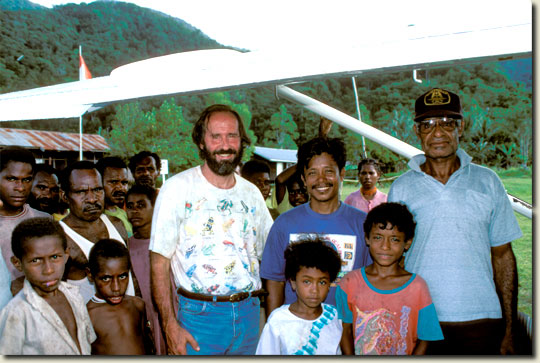
Heiko was on all of his Mamberamo-expeditions welcome by the native people –
but never by the military… The only access is by charted plane
 The giant Mamberamo area with undreds of unexplored rivers where no one lives –
The giant Mamberamo area with undreds of unexplored rivers where no one lives –
or has ever lived

Also the hundreds of isolated Lakes have never been explored –
most of these cannot be found on maps

The Mamberamo river itself is a large river – uninhabitat…

One Javanese man settled in Dabra and makes use of the tilapine cichlids Dutch
had introduced, which have multiplied by the millions in the giant Valley

Heiko lived wih the primitive natives for some time…

Melanotaenia praecox was described in 1910, but it wasn’t until Heiko collected
and brought them back alive that anyone know its fantastic color
5. Another very interesting project Heiko is working on: the research of probably the most amazing freshwater fish behavior on Earth, members of the family Umbridae (Salmoniformes). From the most northern part of Siberia have been recorded two species, Dallia admirabilis and D. delicatissima, which seem to have both a live cycle not found in any other fish. Besides having to live in waters almost completely lacking of oxygen and therefore having adapted to use their swim-bladder for addition atmospheric respiration, they can remain frozen for a very long period of time and return to life when thawed. In addition there are other species of this unique family worth researching further, about their ecology and biology, specially the monotypic species Novumbra hubbsi, living only on the Olimpic peninsula, in Washington State, USA, and the behavior of the most northerly exclusively freshwater fish Dallia pectoralis.

Dallia delicatissima, the amazing Siberian salmoniform fish, which was never
photographed alive. Design courtesy of Acad. SCI former USSR
This is only of Heiko’s research expedition projected for the near future. There is much more of such unique behavior in the freshwater vertebrates hardly ever studied … behavior from which Man can learn more than from anything else … (or is there anyone who does not believe that we learned everything from nature?)
6. And last but not least, another ongoing unique project is to study further the biology of the deepest freshwater fish species on Earth. In the oldest freshwater lake on Earth, Lake Baikal, which is for about 21 million years almost unchanged, lives a member of the endemic family Comephoridae, Comephorus baicalensis. It has probably the most fascinating reproduction behavior known. This species lives at the bottom of Lake Baikal at an average of 1.7 kilometer depth and cannot bear at such depth its young. Therefore it has to swim to the surface of the lake and literally explodes by doing so, but this gives the young the chance to swim out of the mother’s stomach and survive. Slowly afterwards these young Comephorus start to swim back down to the bottom of the lake, were they live their entire life cycle.

Comephorus baicalensis, the deepest living freshwater fish species on Earth
Publication Projects – Popular and Scientific
1. Since 1985 Heiko Bleher is working on a giant book project about The Fresh and Brackish Fishes. Several publication dates have been projected and announced in the past, but do to different reasons the date has always been altered – postponed. In the meanwhile Heiko has continued to write – over 3200 pages written on this date – and never stopped. This book has been expanded into three volumes with more than 25,000 fish forms photographed, each with its correct/exact location, were it was found. Surely this unique book will be published, but before it is finally in press he will not announce its date.
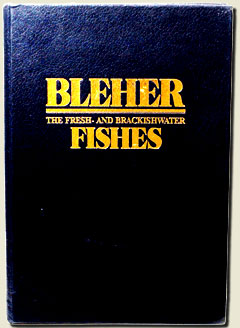
A book Heiko Bleher is working on for the last 20plus years –
so far divided in 3 volumes with more than 3200 pages…
2. Heiko is working on a project for Tropical Aquarium Fishes with about 3000 of the fresh and brackish water fishes kept in aquariums around the globe. Including details about their reproduction, distribution, habitats, water parameters, and varieties found and breed. This work will be a book for every tropical aquarium fish lover, beginner or advanced. It will be as complete, probably as never done before and cover every tropical fish anyone wants – and only those available in the hobby.
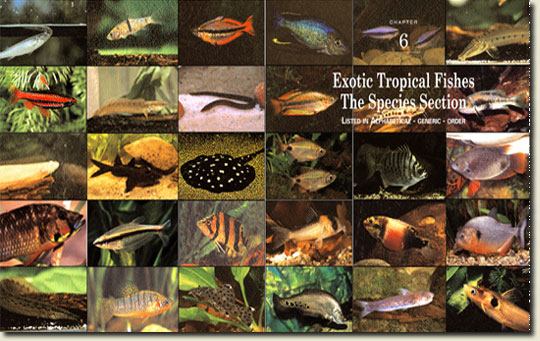
3. Another book project Heiko wants to finalize soon, is that of the Rainbowfishes. Probably no one has ever collected as many rainbowfishes (family Melanotaeniidae), blue eyes (family Pseudomugilidae) and Sulawesi rainbowfishes (family Telmatherinidae) as Heiko – throughout Australasia and Indonesia. This book will be as complete as his BLEHER’S DISCUS volume 1, and done in a very similar fashion.

Melanotaenia sp., with Heiko discovered near Kiunga

Pseudomugil sp., probably new, which Heiko discovered 2007 on the Aru Islands

Pseudomugil cf. gertrudae, also a 2007 discovery on the Aru Islands
4. Since the 1970 Heiko has traveled and done field trips throughout Africa (visiting all countries) and collected possibly more species of the family Cichlidae than any other person (except for the Rift lake cichlids, which have been covered extensively and very well by others). He has introduced several new species and forms or variants of the genus’ Anomalochromis, Astatotilapia, Benitochromis, Chromidotilapia, Ctenochromis, Cyclopharynx, Gobiocihla, Hemichromis, Heterochromis, Lamprologus, Konia, Limbochromis, Myaka, Nanochromis, Oreochromis, Orthochromis, Parananochromis, Pelmatochromis, Pelvicachromis, Pseudocrenilabrus, Pungu, Sarotherodon, Steatocranus, Schwetzochromis, Teleogramma, Thoracochromis, Thysochromis, Tilapia, Torachromis and Tylochromis, as well as some new species and genera.
This book will be done in the same fashion as his other books …

Schwetzochromis neodon was collected for the first time alive by Heiko Bleher
in the Lake Fwa in the 1980s

The true Nanochromis dimidiatus was also collected first by Heiko begin of the 1980s
5. Being the managing editor for aqua, International Journal of Ichthyology, which is been published since 1992 with 4 to 6 issues per year, Heiko is responsible for the quality of this world-wide recognized journal to improve constantly. The major ichthyologists and scientists have published in aqua and lately Heiko has, for the first time, worked for almost three year with leading molecular scientists, on the Revision of the genus Symphysodon Heckel, 1840, which has been published 1st August 2007.
-cover.jpg)
Revision of the Genus Symphysodon Heckel, 1840 (Teleostei: Perciformes: Cichlidae)
based on molecular and morphological characters
by Heiko Bleher, Kai N. Stölting, Walter Salzburger and Axel Meyer.
New Scientific publication – to be delivered starting August 1, 2007 world-wide
6. Special publications are also since 2003 being produced by Aquapress Publishers, those are incorporated in aqua, but distributed and sold separately. Not by subscription. There are projects for special publications like: one on new species from the Vogelkop Peninsula in New Guinea including two new sharks, a pristine area, unique coral reefs with an amazing variety of species, which is in urgent need for protection. As a matter of a fact, those species names will be auctioned by Christies of London during a special event, so called “Blue Night” in Monte Carlo under the presence of Prince Rainer of Monaco … all the money will go for the protection of this Vogelkop Peninsula region.
A second one the late Jacques Géry worked on and hopefully will be finished soon, is about the Characiform fishes of the Rio Guaporé basin – nearly 200 species of which 20 are new.

The true Serrasalmus nattereri (or genus Pygocentrus) from the Rio Guaporé,
were Natterer found it and were he made the drawing
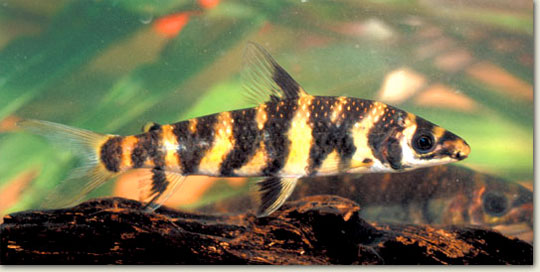
Leoporinus bleheri, discovered by Heiko in the Guaporé basin
And more to come …
This post is also available in: English Italian German French Spanish







